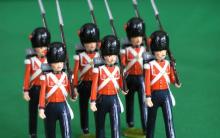We've answered the most popular questions - check, maybe we've answered yours too?
- We are a cultural institution and want to broadcast on the Kultura.RF portal. Where should we go?
- How to propose an event to the portal’s “Poster”?
- I found an error in a publication on the portal. How to tell the editors?
I subscribed to push notifications, but the offer appears every day
We use cookies on the portal to remember your visits. If cookies are deleted, the subscription offer will pop up again. Open your browser settings and make sure that the “Delete cookies” option is not marked “Delete every time you exit the browser.”
I want to be the first to know about new materials and projects of the portal “Culture.RF”
If you have an idea for a broadcast, but there is no technical ability to carry it out, we suggest filling out electronic form applications within national project"Culture": . If the event is scheduled between September 1 and November 30, 2019, the application can be submitted from June 28 to July 28, 2019 (inclusive). The selection of events that will receive support is carried out by an expert commission of the Ministry of Culture of the Russian Federation.
Our museum (institution) is not on the portal. How to add it?
You can add an institution to the portal using the “Unified Information Space in the Field of Culture” system: . Join it and add your places and events in accordance with. After checking by the moderator, information about the institution will appear on the Kultura.RF portal.
In the second half of the 19th century, Emperor Mutsuhito ascended the throne, under whom Japan ended its policy of self-isolation and transformed from a backward agricultural country into one of the leading states in the world. Changes under Mutsuhito, who took the name Meiji (which meant “enlightened rule”), affected not only the political and economic sphere, but also the cultural sphere. Thus, under him, the art of enamellers experienced its heyday, who began to produce their products not only for the domestic, but also for the foreign market.
Samples of works from the workshops of Japanese enamellers will be brought to Moscow as part of the exhibition “Beyond Imagination. hidden treasures imperial japan XIX - early XX centuries from the collection of Professor Khalili." And - not only them. In total, 90 exhibits will be exhibited in the halls of the Moscow Kremlin Museums. All of them have recently entered Professor Khalili’s collection and are being shown for the first time.
Censer. Japan, circa 1885 Made in the workshop of Namikawa Sosuke.
Copper, shakudo and shibuichi alloys, bronze, silver, gold; enamel, gilding, casting, carving, embossing.

Decorative composition. Japan, around 1900 Master Oshima Joun.
Bronze, silver, gold, shibuichi alloy; casting, iroe takazogan and hanzogan inlay techniques, soldering

Figure of a goose. Japan, circa 1880-1885 Probably made in the workshop of Namikawa Sosuke.
Enameling using the cloisonné technique with partitions made of silver wire; the beak is made of shakudo alloy, the paws are made of gilded bronze

Tray. Japan, circa 1900 Made in the workshop of Namikawa Sosuke based on a design by Ogata Korin (1658-1716).
Enameling using Moriage and Cloisonné techniques; shakudo alloy frame
The famous British scientist and philanthropist Nasser David Khalili began collecting his collection in the 1970s. And he pursued a specific goal - to find around the world, buy and save for posterity best samples Japanese decorative and applied arts from the reign of Emperor Mutsuhito. In the Assumption Belfry and the exhibition hall of the Patriarchal Palace, visitors to the exhibition will see interior items - incense burners, trays, boxes, screens and decorative compositions. One of them is the “Figure of a Goose”, which was made in the workshop of Namikawa Sosuke using the cloisonné technique with partitions made of silver wire.
A must-see exhibition for all those who are fans of Japanese tattoos has opened in the exhibition hall of the Assumption Belfry of the Patriarchal Palace in the Moscow Kremlin. The exhibits have no connection with irezumi (traditional Japanese tattooing), but they are an excellent reflection of the artistic component of the culture of the Land of the Rising Sun.

Appeared unique chance get a dose of inspiration and additional knowledge by looking at the masterpieces of decorative and applied arts of Japan. Agree, it is much better to use original works for the purpose of self-education and enriching your knowledge, rather than books or, as most often happens, pictures downloaded from the Internet.

Part of the collection of a British man of Iranian origin named Nasser David Khalili. He managed to collect unique items art XIX-XX created by Japanese masters. Today there is a chance to see more than 90 objects, a significant part of which are famous all over the world japanese kimono, decorated in different techniques (embroidery with steel and silk threads, painting, batik).

In addition to kimonos, the exhibition presents other masterpieces created by craftsmen who were official suppliers of the imperial court: artistic metal, enamel, figurines, vases and other examples of decorative and applied art are available in the halls of the Moscow Kremlin until October 1, 2017. See details on the official website of the exhibition - khalilicollection.kreml.ru. By the way, the organizers of the exhibition announced two lectures that will undoubtedly be of interest to lovers of everything oriental: September 16, 2017 "Japan, open to the world» and September 17, 2017 "Japan in the Meiji Era".
This week the exhibition “Beyond Imagination” opens. Treasures of Imperial Japan of the 19th - early 20th centuries from the collection of Professor Khalili." For the first time in Russia, part of a unique collection will be shown, the basis of which was laid in the 1970s by the world-famous British scientist, collector and philanthropist Nasser David Khalili. "Kommersant Style" about what is remarkable about the collection and what else the Khalili family owns.
Second half XIX century became a time of great economic, political and cultural change for Japan. Under the leadership of Emperor Mutsuhito, better known as Meiji, who came to power in 1967, the country, previously almost completely isolated from the West, became one of the strongest powers in just half a century.
By opening the borders of Japan, Meiji put an end to not only economic and political, but also cultural isolation from the rest of the world. High interest in Japanese culture on the part of Western collectors, as well as the desire of the imperial court to keep up with the times, prompted craftsmen engaged in traditional crafts to update the design of their products and master modern technologies their creation. This combination of ancient traditions, new technical capabilities and foreign influence is a unique feature of the masterpieces of decorative and applied art of the Meiji era, which can be seen from July 5 to October 1 at the Moscow Kremlin Museums.
Exhibition “Beyond Imagination. Treasures of Imperial Japan of the 19th - early 20th centuries from the collection of Professor Khalili" will present about 90 exhibits, many of which were made for members imperial family or by order of large trading companies. Among them are products of Japanese enamellers (vases, incense burners, screens, trays and boxes), whose art experienced rapid flowering during that period; rare examples of silk embroidery, artistic metal and porcelain.
A special part of the exhibition will include never before shown kimonos from the Edo and Meiji periods, created from traditional Japanese silk and highly valued imported fabrics. All the items that will be shown at the Moscow Kremlin Museums have recently become part of the collection and are being exhibited for the first time.
The collection of decorative and applied arts of the Meiji era, owned by British billionaire and philanthropist Nasser David Halili, is the largest in the world: about 1,200 exhibits. Describing himself as a collector, Khalili emphasizes that he acquires endangered traditional crafts in order to preserve the best examples for future generations. Today the Khalili family owns eight collections, which in total number about 35 thousand objects. Among them is a unique collection of Islamic art, a rare collection of documents from Ancient Bactria, as well as the largest in the world private collection enamels (exhibited in 2009–2010 at an exhibition in the Hermitage).
“Beyond imagination. Treasures of Imperial Japan of the 19th - early 20th centuries from the collection of Professor Khalili", exhibition hall of the Patriarchal Palace, Showroom Assumption belfry of the Moscow Kremlin
This summer, the Moscow Kremlin Museums hosted a truly unique exhibition, both in terms of content and in contrast to the site itself. Ninety pieces from the mesmerizing collection of Meiji-era Japanese art assembled by renowned scholar and philanthropist Professor Nasser D. Khalili are displayed in the whitewashed interiors of the Patriarchal Palace and the Assumption Belfry. It is the largest collection of Meiji era (1868-1912) objects in the world. And even if you don’t know anything about historical and cultural aspects Japanese art, you still won’t remain indifferent. Each of the exhibited items captures the imagination; you can look at them for hours.
Introduction to vases, kimonos, decorative sculptures, screens and so on, without exaggeration, transports the viewer to another world. All these works are not just an illustration of the era or something abstractly “beautiful”. They embody the tradition of Japanese aesthetics and attitude to things, which has been formed over hundreds of years. The peculiarity of the Meiji era is that at that time Japan abandoned self-isolation, opened up to the world, demonstrating the best that is in its culture and partly accepting some of the “rules of the game” of the Western world. Meiji means “enlightened rule” - this is the name chosen by Emperor Mutsuhito, who led the country at that time.
In an interview with Kulturomania, Fyodor Mikhailovich Panfilov, one of the curators of the exhibition, a researcher at the Moscow Kremlin Museums, emphasizes: “The exhibition covers several important periods in Japanese history, from late Edo to Taisho. Most of the exhibits date back to the Meiji era. Presented at the exhibition best works Decorative and applied arts of this time show how new technological solutions were combined with time-tested craftsmanship and the desire for perfection. Throughout the 20th century, the art of the Meiji era remained undeservedly forgotten. And Professor Khalili's collection, which has no equal outside Japan, had great importance to revive interest in this period, both among researchers and the general public. I note that some of the exhibits are being shown for the first time.”
What first strikes the Western viewer? Maybe, careful attitude to the seemingly simple household item: a tray, a secretary or, say, a vase. They are not just skillfully decorated by craftsmen: each item is a thing, that is, something that requires especially careful treatment, attention and care.
The point is that on japanese art Shintoism was strongly influenced, and according to it, things contain deities. This means that the subject must be treated appropriately. That is why the works of art presented in the collection are so attractive: behind each of them there is a special philosophy that requires the artist to have skill, taste and flair, which will allow him to create a harmonious object. This is especially true for ceremonial items such as kimonos: custom-made silk garments are decorated with patterns - symbols, landscapes, scenes from legends. They are made using the batik technique, using silk embroidery, metal threads and stencil painting. It’s even difficult to imagine, for example, a kimono (1780-1830s), made for the wedding of a high-ranking samurai and decorated with ribbons of dried abalone, a shellfish symbolic of Japan. Or, say, an outer kimono for a young woman (1830-1870) with scenes from “The Tale of Ise” admiring Mount Fuji. It’s hard to imagine, so you have to go and see.
“Many of these objects were created for Western connoisseurs and participated in world exhibitions in Europe and the USA. Or they were ordered by the imperial court and presented as gifts to high-ranking officials and diplomats. In any case, great importance was attached to the aesthetic side, although some things could be used for domestic purposes,” Fyodor Panfilov says in an interview with Kulturomania.
Most of These works of art are decorated with symbols that are understandable to the people of Japan. These are the crane, turtle, pine, bamboo and plum, which bring happiness; the fantastic khoo birds, whose tail plumage indicates honesty, wisdom, integrity and chastity; carp, shellfish... countless different creatures and plants. No less popular subjects were scenes from literary works– “Ise Monogatari”, “The Tale of Genji” and others. Thus, through these objects one can become acquainted not only with the decorative and applied arts of Japan, but also with its rich literary and religious history.
Researchers emphasize that during the Meiji era, artists began to turn to Western techniques for processing materials and styles. They were organically combined with traditional techniques, resulting in, say, an okimono with a carp (a decorative object, literally “that which is placed”) by the master Oshima Joun, in which the curves of Art Nouveau are used in the image of waves. But what is most impressive is the gentle subjects that are characteristic of Japan, discreet at first glance, executed in watercolor tones or even almost colorless. For example, a tray from the studio of Namikawa Sosuke, depicting a blossoming plum shoot against the background of the moon. It is made using enamel and looks like it is an ink painting.
A special place in the exhibition is occupied by swords, armor and other items for samurai. The fact is that during the Meiji era this class was actually abolished, and samurai were forbidden to carry weapons. Therefore, richly decorated swords are, in general, no longer weapons, but a memory of the passing original Japanese culture, which in late XIX century enters into active interaction with the West.
“Even without knowing anything about Japanese culture, you can appreciate highest level the skill with which these objects are created - it is no coincidence that the “golden age” of enamels in Japan belongs to the Meiji era. The beautifully published exhibition catalog can be recommended to anyone interested in this period. Many exhibits are described in detail in the text of the labels, and the explications in the halls contain the necessary information about artistic metal, cloisonne enamels and kimonos,” says the curator of the exhibition.
Exhibition “Beyond Imagination. Treasures of Imperial Japan of the 19th-20th centuries from the collection of Professor Khalili" will last until October 1, 2017 in the Patriarchal Palace and the Assumption Belfry (Moscow Kremlin Museums)











First Chinese Emperor
Alfred the Great: biography
Armenian king 4. Great Armenian kings. Kings of the Great Armenian Empire
Tsarevo █ Church of St. Nicholas the Wonderworker Tsarevo parish festive service June 05
Revival of the Sergius Church